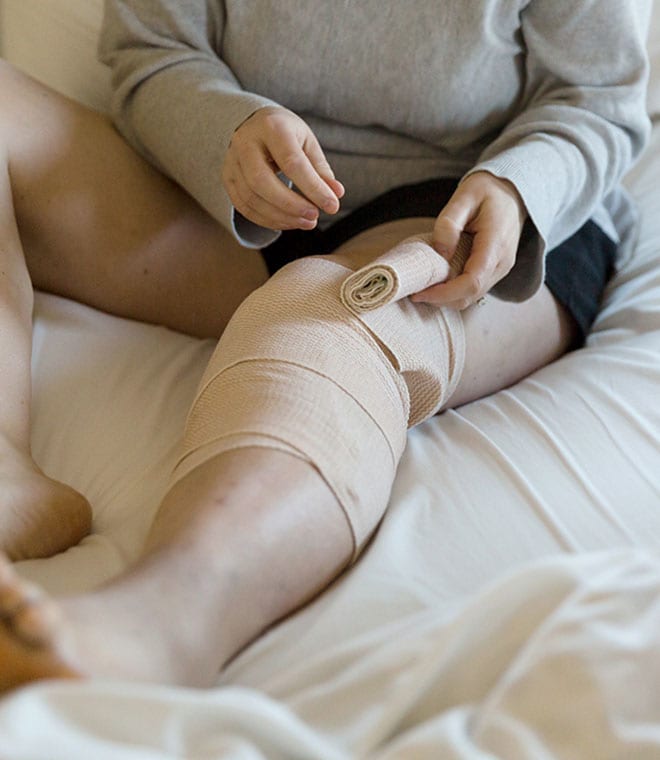Health
What is plantar fasciitis?
By Dennis Galvon, MD May 28, 2024 • 8 min
Approximately 1 in 10 people will develop plantar fasciitis at some point in their lives. While the condition can be painful and debilitating in some cases, there are many self-care therapies and treatment options available to help address the pain and promote healing.
What is the plantar fascia?
The plantar fascia is the very tough band of fibrous connective tissue that extends from your heel to the ball of your foot before branching off to each of your toes. The job of the plantar fascia is to connect all the bones of your foot and provide support through your arch.
What does plantar fasciitis mean?
When your foot moves, your plantar fascia stretches to accommodate your movements, and then it typically returns to its original shape. It’s possible for the plantar fascia to stretch too far or suffer from overuse, and when this occurs, the plantar fascia can become inflamed — a condition known as plantar fasciitis. The fascia becomes less flexible as we age, so this condition is more common in people over age 40.
What causes plantar fasciitis?
You can develop plantar fasciitis from anything that strains, damages or irritates the plantar fascia. Some possible risk factors for developing plantar fasciitis include:
- Sports injuries
- Exercising or working on a hard surface
- Failing to stretch and warm up before exercise
- Standing for long periods while at work or performing chores
- Wearing shoes that don’t offer enough support
- Standing or walking barefoot
- Being overweight or obese
- Having high arches or flat feet
- Lack of flexibility from your back down the backs of your leg
- Getting older and not stretching enough
What does plantar fasciitis feel like?
Foot pain, especially heel pain, is the most common symptom of plantar fasciitis. Some people experience the pain most sharply when they stand up after sitting or lying down and then notice that the discomfort resolves within a few minutes. Others report a more constant, dull ache, or a sharp or stabbing pain when they put weight on the affected foot. In some cases, exercise may temporarily alleviate plantar fasciitis pain, only for it to return after resting.
Other symptoms of plantar fasciitis include:
- Stiffness in the feet
- Swelling in the heel area
- Tightness in the Achilles tendon
- Tenderness, especially along the bottom of the foot or the heel
What are plantar fasciitis treatment options?
Although plantar fasciitis can interfere with daily activities, the condition often resolves with treatment. In fact, 90% of people recover within 6 to 18 months with an appropriate treatment plan, which may include one or more of the following treatments:
1. Cold therapy: Applying ice packs, cold compresses or cold water bottles to the foot a few times per day may help alleviate inflammation and the associated pain. Your healthcare provider can tell you how many times per day to use cold therapy and how long each session should be.
2. Over-the-counter pain relievers: For mild to moderate plantar fasciitis pain, healthcare providers may recommend over-the-counter pain medications. Because they ease inflammation as well as pain, nonsteroidal anti-inflammatory drugs (NSAIDs), like ibuprofen and naproxen, are often the first choice. Those who are unable to safely use NSAIDs may be advised to take acetaminophen instead.
3. Plantar fasciitis stretches: Stretching the plantar fascia and Achilles tendon may help relieve plantar fasciitis pain, since the condition is related to a lack of flexibility from the foot and lower leg muscles. Your healthcare provider may show you how to perform specific stretches or refer you to a physical therapist who can develop a stretching program based on your needs.
4. Activity modification: While recovering from plantar fasciitis, you may need to modify your activities. For example, you may need to switch from exercises that place stress on the plantar fascia, such as running on pavement or dancing, to gentler activities like swimming or cycling.
5. Mobility aids: Putting less weight on the affected foot may help aid in the healing process. Your healthcare provider may recommend the short-term use of a cane or crutches while you recover.
6. Orthotics, medical devices and immobilization: Reducing the range of motion of your foot and/or increasing support for your movements may reduce pain and help the plantar fascia heal. This may be done with orthotics, medical devices or immobilization techniques, as directed by your healthcare provider, such as:
- Wearing a boot cast for a few weeks
- Using plantar fasciitis inserts your shoes
- Wearing a plantar fasciitis night splint while you sleep
- Switching to custom-made shoes
7. Shock wave therapy: Also known as ESWT, shock wave therapy involves the use of high-energy shock waves. Studies into the effectiveness of ESWT have yielded mixed results, but some people may experience a reduction in pain and inflammation from the therapy.
8. Injections: In some cases, injecting certain medications into the foot may successfully treat plantar fasciitis. Injection medications may include:
- Corticosteroids to suppress inflammation
- Platelet-rich plasma sourced from your own blood to stimulate healing
- Botulinum toxin (Botox) to relax tissues and help ease pain
9. Ultrasonic tissue repair: A minimally invasive procedure, ultrasonic tissue repair helps remove damaged tissue from the plantar fascia. During the treatment, a doctor inserts a needle-like probe into your foot to produce ultrasonic vibrations that loosen damaged tissues, which can then be suctioned away.
10. Surgery: When other treatments are unsuccessful at easing symptoms of plantar fasciitis, healthcare providers may recommend more invasive surgeries. There are two main procedures:
- Partial plantar fascia release: A surgeon makes a small incision in the plantar fascia to relieve tension.
- Gastrocnemius recession: A surgeon makes a small incision in the leg and then lengthens one of two muscles in the calf to reduce pressure on the plantar fascia.
Seek care for plantar fasciitis
If you have symptoms of plantar fasciitis, see your healthcare provider. They can help you decide which treatments are right for you and give you advice on lifestyle changes that can help prevent symptoms from returning in the future.
Updated May 2024.
Sources:
- https://my.clevelandclinic.org/health/diseases/14709-plantar-fasciitis
- https://www.health.harvard.edu/pain/plantar-fasciitis-symptoms-causes-and-treatments
- https://www.hopkinsmedicine.org/health/conditions-and-diseases/plantar-fasciitis
- https://www.mayoclinic.org/diseases-conditions/plantar-fasciitis/diagnosis-treatment/drc-20354851
- https://www.mountsinai.org/health-library/diseases-conditions/plantar-fasciitis
- https://orthoinfo.aaos.org/en/diseases--conditions/plantar-fasciitis-and-bone-spurs



